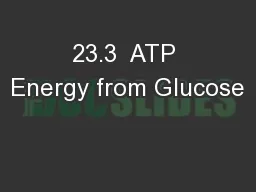

The malateaspartate shuttle transfers the energy stored in NADH to transporters that move from the cytosol into the mitochondrial matrix where NADH is regenerated for use in electron transport Learning Goal ID: 601636
Download Presentation The PPT/PDF document "23.3 ATP Energy from Glucose" is the property of its rightful owner. Permission is granted to download and print the materials on this web site for personal, non-commercial use only, and to display it on your personal computer provided you do not modify the materials and that you retain all copyright notices contained in the materials. By downloading content from our website, you accept the terms of this agreement.
Slide1
23.3 ATP Energy from Glucose
The malate–aspartate shuttle transfers the energy stored in NADH to transporters that move from the cytosol into the mitochondrial matrix, where NADH is regenerated for use in electron transport
Learning Goal Account for the ATP produced by the complete oxidation of glucose.Slide2
ATP from Glycolysis
The total ATP from complete oxidation of glucose is calculated by combining the ATP produced from glycolysis (glucose produces 7 ATP):
five ATP from two NADH (malate–aspartate shuttle) and two ATP from direct phosphate transfer.the oxidation of pyruvate.the citric acid cycle.electron transport.In glycolysis, the oxidation of glucose stores energy in two NADH molecules and two ATP molecules from direct phosphate transfer. Slide3
Malate–Aspartate Shuttle
Because glycolysis occurs in the cytosol,the NADH produced cannot pass through the mitochondrial inner membrane.the hydrogen ions and electrons from NADH can be moved in and out of the mitochondria by a transporter, the
malate–aspartate shuttle.malate dehydrogenase catalyzes the reaction of oxaloacetate and NADH to yield malate and NAD+.a transporter binds the malate and carries it across the membrane into the matrix, where malate dehydrogenase oxidizes malate back to oxaloacetate.Slide4
Malate–Aspartate Shuttle, ATP
The oxidation to oxaloacetate provides hydrogen ions and electrons that are used to reduce NAD+ to NADH, which can now enter electron transport to synthesize ATP
.Slide5
Malate–Aspartate Shuttle, ATP
Because the oxaloacetate produced in the matrix cannot cross the mitochondrial membrane, itis converted back to aspartate;moves out of the matrix back into the cytosol; and
undergoes transamination, which converts it to oxaloacetate.The resulting NAD+ can participate again in glycolysis in the cytosol.Slide6
ATP from Oxidation of Pyruvate
Under aerobic conditions, pyruvateenters the mitochondria.is oxidized to give acetyl CoA, CO2
, and NADH.Because glucose yields two pyruvate, two NADH enter electron transport.their oxidation leads to the production of five ATP.Slide7
ATP from Citric Acid Cycle
The two acetyl CoA produced from two pyruvate enter the citric acid cycle. Two acetyl CoA from one glucose produce a total of six NADH;two FADH2
; andtwo ATP.In electron transport, six NADH produce 15 ATP, and two FADH2 produce 3 ATP. Slide8
ATP from Citric Acid Cycle
In two turns of the citric acid cycle, a total of 20 ATP are produced. 6 NADH × 2.5 ATP
/NADH = 15 ATP 2 FADH2 × 1.5 ATP/FADH2 = 3 ATP 2 GTP × 1 ATP/GTP = 2 ATP Total two turns = 20 ATP The overall equation for the reaction of two acetyl CoA isSlide9
ATP from Oxidation of Glucose
Core Chemistry Skill
Calculating the ATP Produced from GlucoseSlide10
Complete Oxidation of Glucose
The complete oxidation of glucose to CO2 and H2O yields a maximum of 32 ATP.Slide11
Chemistry Link to Health:
Efficiency of ATP ProductionIn a laboratory calorimeter, 1 mole of glucose produces 690 kcal.
C6H12O6 + 6O2 6CO2 + 6H2O + 690 kcalTo calculate the ATP energy produced in the mitochondria from glucose, we use the energy of the hydrolysis of ATP (7.3 kcal/mole of ATP). Slide12
Chemistry Link to Health:
Efficiency of ATP ProductionOur cells are about 33% efficient in converting the total available chemical energy in glucose to ATP.
The remainder of the energy produced from glucose during the oxidation in our cells is lost as heat.Slide13
Concept Map